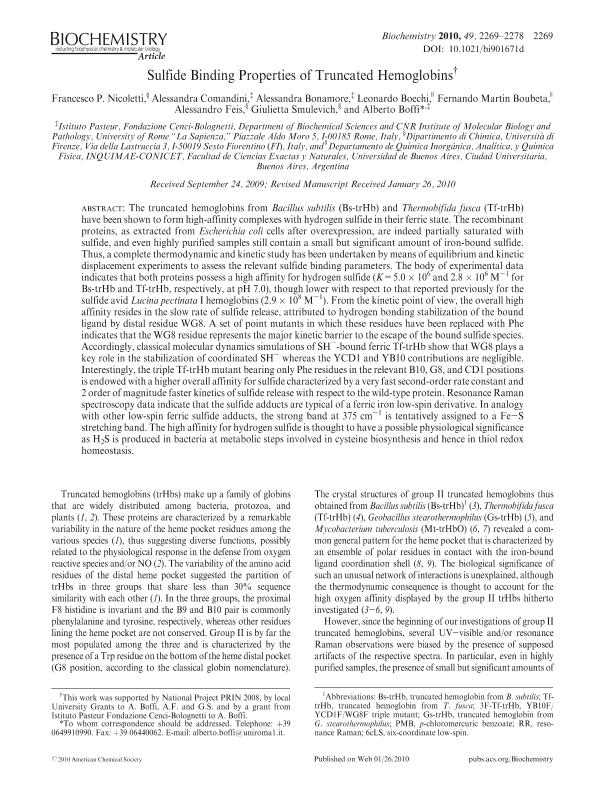Artículo
Sulfide binding properties of truncated hemoglobins
Nicoletti, Francesco P.; Comandini, Alessandra; Bonamore, Alessandra; Boechi, Leonardo ; Boubeta, Fernando Martín
; Boubeta, Fernando Martín ; Feis, Alessandro; Smulevich, Iulietta; Boffi, Alberto
; Feis, Alessandro; Smulevich, Iulietta; Boffi, Alberto
 ; Boubeta, Fernando Martín
; Boubeta, Fernando Martín ; Feis, Alessandro; Smulevich, Iulietta; Boffi, Alberto
; Feis, Alessandro; Smulevich, Iulietta; Boffi, Alberto
Fecha de publicación:
03/2010
Editorial:
American Chemical Society
Revista:
Biochemistry
ISSN:
0006-2960
Idioma:
Inglés
Tipo de recurso:
Artículo publicado
Clasificación temática:
Resumen
The truncated hemoglobins from Bacillus subtilis (Bs-trHb) and Thermobifida fusca (Tf-trHb) have been shown to form high-affinity complexes with hydrogen sulfide in their ferric state. The recombinant proteins, as extracted, from Escherichia coli cells after overexpression, are indeed partially saturated with sulfide, and even highly purified samples still contain a small but significant amount of iron-bound sulfide. Thus, a complete thermodynamic and kinetic study has been undertaken by means of equilibrium and kinetic displacement experiments to assess the relevant sulfide binding parameters. The body of experimental data indicates that both proteins possess a high, affinity for hydrogen sulfide (K= 5.0 × 106 and 28 × 106 M-1 for Bs-trHb and Tf-trHb, respectively, at pH 7.0), though, lower with, respect to that reported previously for the sulfide avid Lucina pectinata I hemoglobins (2.9 × 108 M-1). From the kinetic point of view, the overall high affinity resides in the slow rate of sulfide release, attributed to hydrogen bonding stabilization of the bound ligand by distal residue WG8. A set of point mutants in which these residues have been replaced with Phe indicates that the WG8 residue represents the major kinetic barrier to the escape of the bound sulfide species. Accordingly, classical molecular dynamics simulations of SH.....-bound ferric Tf-trHb show that WG8 plays a key role in the stabilization of coordinated SH -whereas the YCD1 and. YB10 contributions are negligible. Interestingly, the triple Tf-trHb mutant bearing only Phe residues in the relevant B10, G8, and CD1 positions is endowed with a higher overall affinity for sulfide characterized, by a very fast second-order rate constant and 2 order of magnitude faster kinetics of sulfide release with respect to the wild-type protein. Resonance Raman spectroscopy data indicate that the sulfide adducts are typical of a ferric iron, low-spin derivative. In analogy with other low-spin ferric sulfide adducts, the strong band at 375 cm-1 is tentatively assigned to a Fe-S stretching band. The high affinity for hydrogen, sulfide is thought to have a possible physiological significance as H2S is produced in bacteria at metabolic steps involved in cysteine biosynthesis and hence in thiol redox homeostasis. © 2010 American Chemical Society.
Palabras clave:
Sulfide-Binding
,
Simulation
,
Truncated-Hemoglobin
Archivos asociados
Licencia
Identificadores
Colecciones
Articulos(INQUIMAE)
Articulos de INST.D/QUIM FIS D/L MATERIALES MEDIOAMB Y ENERGIA
Articulos de INST.D/QUIM FIS D/L MATERIALES MEDIOAMB Y ENERGIA
Citación
Nicoletti, Francesco P.; Comandini, Alessandra; Bonamore, Alessandra; Boechi, Leonardo; Boubeta, Fernando Martín; et al.; Sulfide binding properties of truncated hemoglobins; American Chemical Society; Biochemistry; 49; 10; 3-2010; 2269-2278
Compartir
Altmétricas



